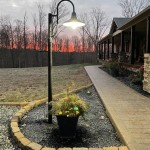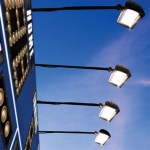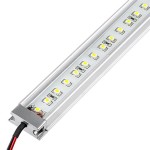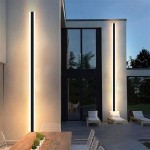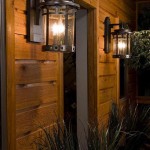```html
How To Outdoor Lighting
Outdoor lighting plays a crucial role in enhancing the aesthetics, security, and functionality of residential and commercial properties. A well-designed outdoor lighting scheme can transform a dark and uninviting exterior into a welcoming and secure environment. This article provides a comprehensive guide on how to effectively plan and implement outdoor lighting, encompassing various aspects from initial planning to fixture selection and installation considerations.
Strategic Planning: Defining Needs and Objectives
Prior to initiating any physical installation, a comprehensive assessment of the property's needs and objectives is paramount. This involves identifying key areas that require illumination, considering the desired ambiance, and evaluating any potential security concerns. The planning phase serves as the foundation for a successful and efficient outdoor lighting design.
One key aspect of planning is to determine the primary purpose of the lighting. Is it primarily for security, focusing on illuminating pathways, entrances, and vulnerable areas? Or is it for aesthetic enhancement, highlighting architectural features, landscaping, or creating a pleasant ambiance for outdoor gatherings? Understanding the purpose will guide the selection of appropriate fixtures, light levels, and placement strategies.
Consider the layout of the property and identify areas that pose potential hazards or security risks. Dark corners, uneven pathways, and entrances are prime locations for targeted lighting solutions. Analyze the architectural style of the building and the existing landscaping to ensure that the lighting design complements the overall aesthetic. A harmonious balance between functionality and visual appeal is essential.
Furthermore, it is vital to consider light pollution and its impact on the surrounding environment. Excessive or poorly directed lighting can contribute to light trespass, affecting neighbors and disrupting nocturnal wildlife. Choosing appropriate light fixtures that minimize upward light spill and using timers or motion sensors can help mitigate these negative effects. Compliant fixtures are often referred to as "Dark Sky Compliant".
Selecting Appropriate Fixtures: Types and Technologies
The market offers a wide array of outdoor lighting fixtures, each designed for specific purposes and aesthetic preferences. Understanding the characteristics and applications of different fixture types is crucial for making informed decisions. Common fixture categories include path lights, spotlights, floodlights, wall lights, and deck lights.
Path lights are typically low-level fixtures designed to illuminate walkways, driveways, and garden paths. They provide subtle illumination for safe navigation without creating excessive glare. Spotlights are used to highlight specific features, such as architectural details, statues, or trees. They offer focused beams of light that draw attention to desired focal points.
Floodlights provide broad illumination for larger areas, such as parking lots, backyards, or security perimeters. They are often used in conjunction with motion sensors to deter potential intruders. Wall lights are mounted on exterior walls to provide ambient lighting or to highlight architectural features. They come in various styles and sizes to complement different building designs.
Deck lights are designed for installation on decks, patios, and other outdoor living spaces. They provide subtle and decorative illumination, creating a relaxing and inviting atmosphere. These lights are often low-voltage and can be integrated into the deck structure for a seamless appearance.
In addition to fixture types, it is important to consider the underlying lighting technology. Incandescent bulbs were traditionally used for outdoor lighting but are now largely replaced by more energy-efficient alternatives. Light-emitting diodes (LEDs) are the most popular choice due to their long lifespan, low energy consumption, and versatility in color temperatures.
LEDs offer significant advantages over other lighting technologies. They consume significantly less energy than incandescent or halogen bulbs, resulting in lower electricity bills. They also have a much longer lifespan, reducing the need for frequent replacements. Furthermore, LEDs are available in a wide range of color temperatures, allowing for customization of the lighting ambiance. Choosing LED fixtures with a warm color temperature (around 2700K to 3000K) is often recommended for creating a cozy and inviting atmosphere.
Installation and Safety Considerations
Proper installation is crucial for ensuring the safety and longevity of outdoor lighting systems. It is essential to adhere to all applicable building codes and electrical regulations. If unfamiliar with electrical work, hiring a qualified electrician is strongly recommended.
Before commencing any installation work, it is imperative to disconnect the power supply to the circuit being worked on. Use appropriate safety equipment, such as insulated gloves and safety glasses. Carefully read and follow the manufacturer's instructions for each fixture being installed.
When installing underground wiring, ensure that it is buried at the appropriate depth to prevent accidental damage. Use direct burial-rated cables specifically designed for outdoor use. Protect the wiring from sharp objects and potential hazards by encasing it in conduit.
Pay close attention to moisture resistance and weatherproofing. Outdoor lighting fixtures should be rated for outdoor use and designed to withstand exposure to rain, snow, and other environmental elements. Proper sealing of connections and enclosures is essential to prevent water damage and electrical hazards.
Consider the placement of transformers for low-voltage lighting systems. Mount them in accessible locations that are protected from the elements. Ensure that the transformers are properly grounded to prevent electrical shocks. Overloading a transformer can cause it to overheat and potentially fail, so it is essential to calculate the total wattage of the connected fixtures and choose a transformer with sufficient capacity.
Regular maintenance is essential for keeping outdoor lighting systems in optimal condition. Periodically inspect fixtures for signs of damage or corrosion. Clean the lenses and reflectors to ensure maximum light output. Replace burned-out bulbs promptly to maintain consistent illumination. Trimming vegetation that obstructs light fixtures is also necessary to prevent shadows and ensure effective lighting coverage.
Timers and light sensors can automate outdoor lighting systems, providing convenience and energy savings. Timers can be programmed to turn lights on and off at specific times, ensuring consistent illumination throughout the night. Light sensors, also known as photocells, automatically turn lights on at dusk and off at dawn, eliminating the need for manual operation.
Motion sensors can be integrated with security lighting systems to provide an added layer of protection. When motion is detected, the lights will automatically turn on, deterring potential intruders and alerting residents to activity in the area. Motion sensors can be adjusted to control the sensitivity and range, minimizing false triggers caused by animals or other non-threatening movements.
The voltage of the system needs consideration. Low-voltage systems are generally safer and easier to install than line-voltage systems. They typically use a transformer to step down the voltage from 120 volts to 12 or 24 volts. Low-voltage systems are well-suited for landscape lighting, path lighting, and deck lighting. Line-voltage systems, on the other hand, operate at the standard household voltage of 120 volts. They are typically used for floodlights, wall lights, and other high-intensity lighting applications.
When planning the layout, carefully consider the placement of each fixture. Avoid creating excessive glare or light trespass onto neighboring properties. Use shields or louvers to direct the light downwards and prevent upward light spill. Position fixtures strategically to highlight desired features and create a balanced and visually appealing lighting scheme.
The spacing of path lights should be determined based on the desired level of illumination and the width of the pathway. Generally, path lights should be spaced 6 to 10 feet apart. For wider pathways, consider using multiple rows of path lights to provide uniform illumination. The height of path lights should also be considered. Lower path lights provide subtle illumination, while taller path lights offer broader coverage.
Properly planned and executed outdoor lighting provides benefits beyond aesthetics and security. It increases property value and enhances the overall enjoyment of outdoor spaces. This contributes to improved safety and creates an inviting and welcoming ambiance.
```
28 Backyard Lighting Ideas How To Hang Outdoor String Lights

Diy Professional Landscape Lighting Installation

How To Light Your Garden At Night Sunset

Outdoor Landscape Lighting Design Tips Ideas Environmental Designs

Top 5 Backyard Lighting Ideas Mike S Landscape

A Landscape Lighting Guide For Beginners Metrogreenscape

Install Landscape Lighting For Added Curb Appeal

How To Install Your Own Outdoor Backyard Lighting My 100 Year Old Home

Landscape Lighting Ideas For Your Front And Backyard The Home Depot

How To Buy Outdoor Lighting Planning And Design Tips Ideas Advice Lamps Plus


